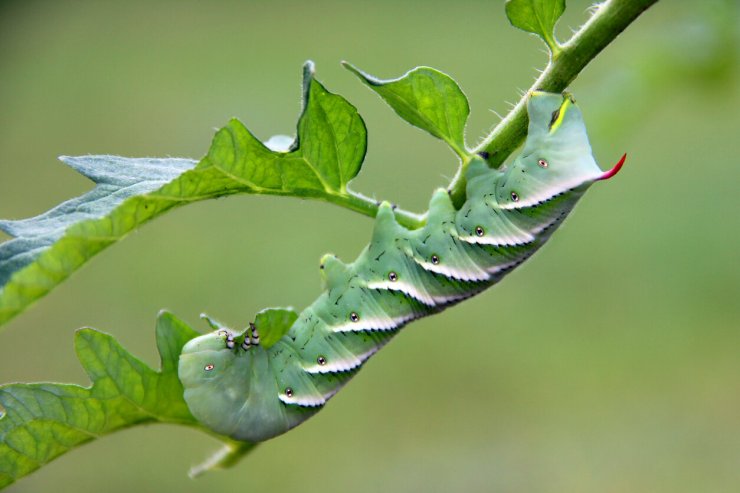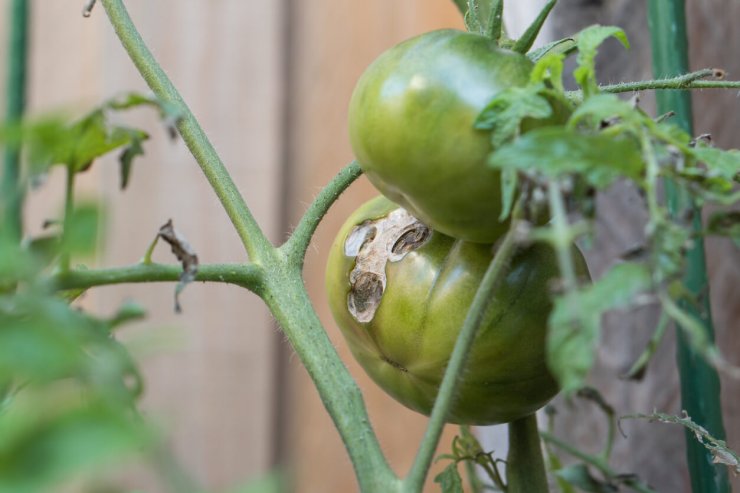
A tobacco hornworm in the tomato garden.
Pests in your tomato garden, left unchecked, can damage and destroy your precious tomato plants. Keeping a close watch on your plants during regular daily inspections will help you spot any pests before they can do irreparable harm.
Spot the Symptoms of Tomato Plant Pests
Check leaves, stems, and fruit for these symptoms that come from pests on the prowl!
| Symptom | Pest |
| Torn or chewed stem | Tomato cutworm (usually occurs early in the season) |
| Defoliation | Tomato hornworm, tobacco hornworm |
| Holes in plant leaves | Flea beetles |
| Yellowing, curling leaves | Aphids |
| Purpling veins in leaves | Psyllids |
| Hole in stem | Stalk borer |
| Honeydew (white, sticky residue) | Aphids, whiteflies |
| Webs on bottom of leaves | Spider mites |
| Symptom | Pest |
| Dark pinpricks, holes in fruit | Tomato fruit worm, stink bugs |
| Light or discolored patches on fruit | Stink bugs |
| Holes in fruit | Slugs |
How to Treat Pests on Tomato Plants

An unripe tomato damaged by caterpillars
Here are some proven ways to get rid of pests on your tomato plants. Choose the best treatment for the type of pests invading your plants.
- Plant basil around them. Basil repels a large number of tomato predators with its potent smell (and makes tomatoes taste better too!).
- Plant marigolds nearby. Marigolds’ bright colors work as a trap crop to attract aphids away from tomatoes.
- Plant collard greens nearby. Use collard greens as a trap crop to attract harlequin bugs away from your tomato plants.
- Plant black-eyed peas nearby. Use black-eyed peas as a trap crop to attract southern green stink bug away from your tomato plants.
- Plant radishes nearby. Use radishes as a trap crop to attract flea beetles away from your tomato plants.
- Plant thyme nearby. Use thyme to fend off adult armyworms so they won’t lay eggs.
- Block them. Put cardboard collars around the base of the stems of your plants and push them into the ground. Ground-level pests won’t be able to get through.
- Pick off the pests. Use your garden gloves to remove the pests by hand. After removal, destroy pests by drowning them in a bucket of soapy water or crushing them with your foot. You can get rid of tomato hornworms by picking them off your tomato plants, crushing them, and then dropping them in the compost. Handpicking isn’t efficient or practical for very small pests but works well with larger pests.
- Blast them. If you spot invaders like aphids, give them a good blast with the garden hose. Chances are good the neighborhood birds will notice and come eat your pests.
- Apply insecticidal soap. Insecticidal soap is organic. The potassium salts in insecticidal soap help remove an insect’s protective waxes, causing destruction of insect membranes and killing them. Mix the soap with water to create your solution and apply directly to insects on any plants. While insecticidal soap is less apt to affect other organisms, certain plants might be sensitive to the soap and can suffer leaf burn.
- Apply horticultural oils. Combine plant- or petroleum-based oils with water to produce horticultural sprays. Neem oil, for instance, is derived from seed extracts of the neem plant. Oil-based sprays block an insect’s air holes, interfere with an insect’s metabolism, disrupt insect feeding, and inhibit insect growth. Like insecticidal soaps, horticultural oils can cause plant injury if not properly diluted.
- Apply a Bt-based biological insecticide. This is a naturally occurring material, based on the bacteria Bacillus thuringiensis. It’s helpful in controlling caterpillars and worms. Spray it on your infested plants. When the worms and/or caterpillars eat the sprayed foliage, they die.
- Make your own pest spray. You can make your own pest spray with benign materials. Mix 1 tablespoon of baking soda, 1/2 teaspoon of a mild dish detergent, and 2 1/2 tablespoons of olive oil in a gallon of water to make a solution that will repel all kinds of bugs, as well as a fungicide for blight and mildew on fruits and plant leaves. Shake it well in your bottle before spraying and repeat every week for it to be continuously effective.
- Use Diatomaceous Earth (DE). Sprinkle DE at base of plants and between plants. Many pests cannot cross over this barrier of sharp microscopic particles without dying.
Do pests attack your tomato plants every year? How do you handle removing them—and even preventing them in the first place? Please tell us how you treat your tomato plants to avoid pests.


 Previous
Previous


This is really helpful!